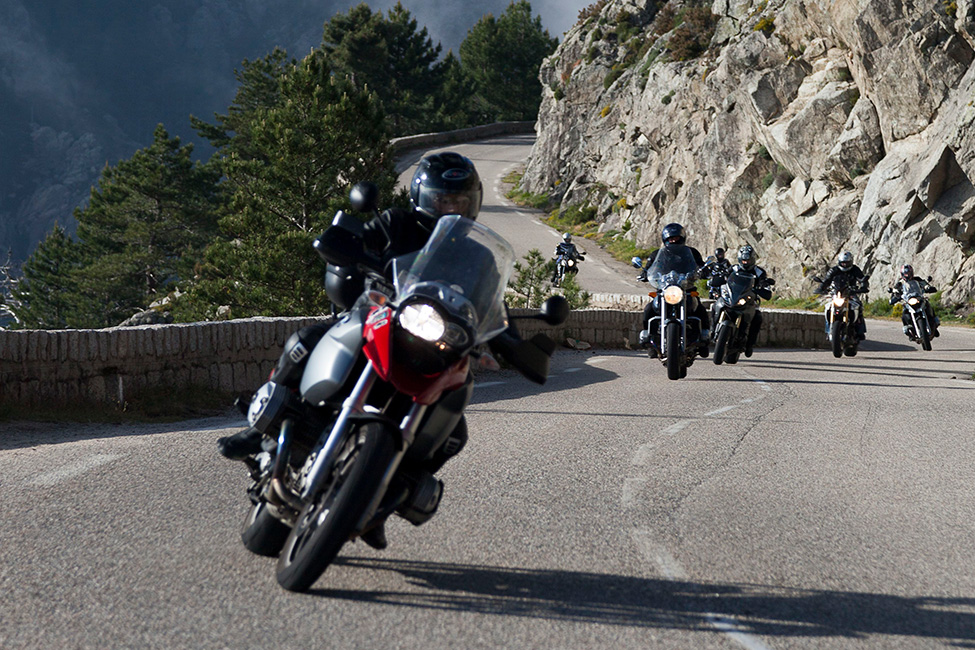Motorcycling in the mountains equals danger!
Motorcycling in the mountains equals danger!

©E. Dautant/hemis.fr
Twisting, turning roads and little traffic: the mountains are the ideal playground for motorcyclists in search of the great outdoors and high-precision cornering. It should however be remembered that the mountains are also fraught with danger…<br />
Treacherous weather conditions
The weather can change really fast up in the mountains. You may start out down in the valley in bright sunshine and find yourself shivering to death just a few hundred metres higher up. It is essential that you take gear for rain and cold weather, even a full change of clothing, just to be on the safe side.
One of the consequences of such extreme and sudden changes in weather is that your visibility can be severely reduced in just a few minutes, sometimes from one valley to the next or even from one bend to the next. Similarly, changes in grip demand more attention on your part, whether you’re riding through a storm or hitting a stretch of road just after the rainfall. Apart from puddles or pools of water or even stretches of smooth tarmac that look like black ice when wet, rubbish carried by gusts of wind can also litter the road surface.
Heaps of leaves, tree branches, spilled crops, clumps of hay or straw can pile up in places due to swirling gusts of wind. Rivers or streams swollen by heavy rainfall can flood the road in places or cause fords. Falling stones or rocks are also a common occurrence, generally indicated by roadside signs all year long. Whenever you see protective netting over rocks or cliffsides, the risk of falling stones or rocks is higher, particularly in the case of bad weather.
Consult different weather websites before starting off to find out what the forecast is for your journey.
Less sophisticated road safety infrastructure
Mountain roads are not always secure and their isolated nature can have serious consequences in the case of an accident, delaying the arrival of emergency services.
Another issue with mountain roads is poor or damaged road surfaces. At the end of winter, the tarmac can be seriously damaged after several weeks of sub-zero temperatures. These devastating effects are visible in the summer (cracks, compression, potholes), at which time maintenance teams are often at work carrying out repairs, leading to mounds of gravel and attendant repair equipment.
Furthermore, even on very isolated roads, you can encounter trucks, coaches, camper vans, tractors or animals… When going around a blind bend, your cornering should take into account this potential threat and aim for a trajectory that affords the best visibility.
Unpredictable hazards can include animals, wildlife or cattle. In the case of cows or sheep, remember that they generally move around in herds. Be particularly wary if you see young animals, whose behaviour can be highly unpredictable. Whatever the case, slow right down and wait for them to leave the road before continuing. There is absolutely no point in shouting at them, opening the throttle or hooting as this will scare most animals, who may turn round and charge at you or simply run amok, including on the road…
Dangerous bends
Hairpin bends should be approached very cautiously. Firstly, because most very tight bends are “blind”, which means that you will only see the exit when you are half-way round the bend itself. Coaches, trucks and trailer vehicles (caravans, tractors, etc) cannot do otherwise than use the entire width of the road to negotiate hairpin bends. If you want to avoid coming head on with the radiator grille of a truck or coach, it’s advisable to negotiate the bend as slowly as possible. What’s more, the tyres of such vehicles tend to rasp when cornering hard, leaving a deposit of slippery rubber on the road. The quality of the road surface of hairpin bends is often also hazardous. “Dishevelled” or “wavy” zones of tarmac in braking areas are commonplace. The gradient can also affect the bike’s ground clearance, if the stand or the exhaust manifold comes into contact with the road surface.
In hairpin bends, even more than for other bends, attempt to approach from the outer edge and turn your head to the maximum to look at the exit of the bend. This will mean that you can drop back if another vehicle arrives head on. To maintain sufficient horsepower to be able to pull out of a hairpin bend, you must downshift one, even two gears on entering the bend, whilst retaining sufficient throttle to not have to change gear in the middle of the bend.
Hairpin bends require careful preparation and you should expect to slow down substantially, whilst calculating to what extent you can widen the trajectory on entering the bend.
Riding downhill may seem simple but is in in fact more treacherous. First and foremost, remember to take into account that braking distances will be increased due to the weight and reduced grip, without forgetting that braking performance can be reduced after having heating up over a long journey. Descents often provide improved visibility however, so you can anticipate the road and any hazards far ahead.
Feel like getting away from it all?
See our suggestions for novel trips and must-see places to visit near your home or holiday destination.